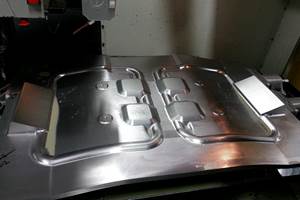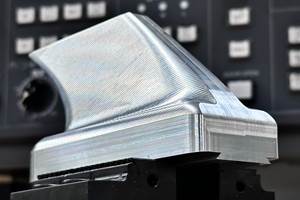How Gaging Flexibility Saves Time and Effort
A gaging system that matches the way parts are made can save you both time and effort.
Share






At the very basic level, a manual gage is created with the specific goal of making it easier to stage and gage a part, reduce operator error, and ensure the best performance for the measuring task at hand. Such designed-for-the-application fixturing can significantly reduce effort for the user and reduce the time required to complete the measuring process.
Another way to save time is to make multiple checks in sequence. A common shopfloor practice is to provide a series of tools for the operator to use in a specialized gaging station. Often, these gages can be connected to a gaging computer through a wired or wireless network. The computer can then provide a guided gaging sequence for the operator, indicating which gage to use in the gaging process, helping him or her make the measurement with pictures/instructions, and collecting the data to provide feedback for part qualification. These workstations and guided sequences provide a sort of automation to give the user clear steps to follow, while all data collection and part qualification is done automatically, thus reducing operator involvement and measurement time.
Measuring time can also be greatly reduced by building a gage that makes multiple measurements at the same time. A custom gage designed to measure multiple diameters, lengths and runouts on a shaft, for example, provides easy loading, no operator influence on results and part qualification within seconds.
Many gage builders have begun using what are known as “standard elements” to create multiple dimensional measurement systems configured for a particular part. The use of these standard elements allows a custom gage to be created in a relatively short amount time for fast implementation, and then potentially allows the gage to be reconfigured for families of similar parts. With this multiple dimensional measuring solution, the gaging sequence is compressed into a one-shot measuring cycle.
The standard elements in these systems tend to be designed with the same robustness as the components used in a custom gage design; the only difference is that there is a common mounting scheme for the items, standard measuring heights, and the ability to use a wide range of transfers, contacts and sensing devices. Therefore, with knowledge of these elements in hand, the gage builder or user can shop from a list of stock items and create a custom gage designed for the specific task at hand, sometimes in days, and usually at a fraction of the cost of a custom-designed part gage.
Gage builders also are employing this build-to-task concept for the measurement and data-collecting part of the solution. The common practice is to use an off-the-shelf computer-based gaging system, often loaded with multiple input capabilities, some I/O, and very capable and powerful measuring software. Many of these software packages bundle together the measuring functions, basic programmable logic control and statistical capabilities in one system. This provides a lot of capabilities, but along with these comes a degree of complexity, often a bit more than the standard gage control technician can handle.
A recent trend being offered by gage builders is a concept similar to the standard mechanical elements, but using electronic modules and software, that allows users to put together a gaging and display package with only the capabilities needed to do the job. This modular electrical concept saves on hardware and software cost and allows the user to build a gaging system tailored to the specific task—nothing less and nothing more.
These systems start with a flexible but simple-to-use software module for taking various gaging inputs and displaying results to the user. The concept often used with these software packages is to take “programming” out of the equation. Rather, measuring tasks are created with a series of icons related to the task at hand. For example, icons can represent a simple one-probe length check or two-probe differential check, or a complex eight-probe concentricity calculation. Thus, all the user needs to do is select the task icon and start measuring parts.
The second part of this standard electronic elements solution is a series of modules that are linked together to create the desired measuring task. These modules for linear variable differential transformer (LVDT) or digital probes, air tooling, and I/O capability are locked together and provide the input data to the modular software via a simple USB interface. The customer only needs those modules that match the application, and since these run on virtually any PC, the user can decide on the solution that best fits his or her application, even using existing manufacturing PCs to do the gaging as part of the operator’s workstation.
In today’s fast-paced manufacturing operations based on flexibility and short runs of precision parts, a gaging system that matches the way parts are made may be the solution to solve your requirements.
Related Content
4 Tips for Staying Profitable in the Face of Change
After more than 40 years in business, this shop has learned how to adapt to stay profitable.
Read More2 Secondary Coordinate Systems You Should Know
Coordinate systems tell a CNC machine where to position the cutting tool during the program’s execution for any purpose that requires the cutting tool to move.
Read MoreCustom Workholding Principles to Live By
Workholding solutions can take on infinite forms and all would be correct to some degree. Follow these tips to help optimize custom workholding solutions.
Read More4 Commonly Misapplied CNC Features
Misapplication of these important CNC features will result in wasted time, wasted or duplicated effort and/or wasted material.
Read MoreRead Next
AMRs Are Moving Into Manufacturing: 4 Considerations for Implementation
AMRs can provide a flexible, easy-to-use automation platform so long as manufacturers choose a suitable task and prepare their facilities.
Read MoreMachine Shop MBA
Making Chips and 91ÊÓƵÍøÕ¾ÎÛ are teaming up for a new podcast series called Machine Shop MBA—designed to help manufacturers measure their success against the industry’s best. Through the lens of the Top Shops benchmarking program, the series explores the KPIs that set high-performing shops apart, from machine utilization and first-pass yield to employee engagement and revenue per employee.
Read More




















